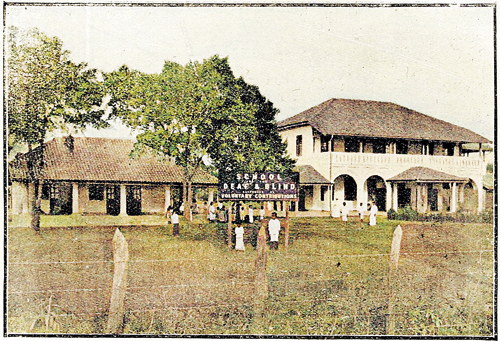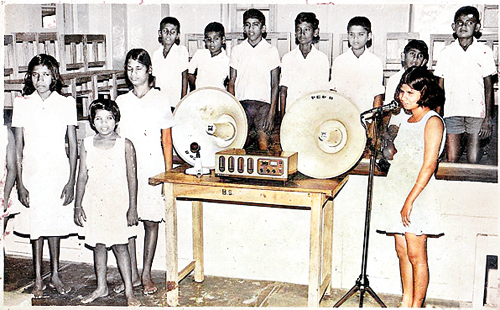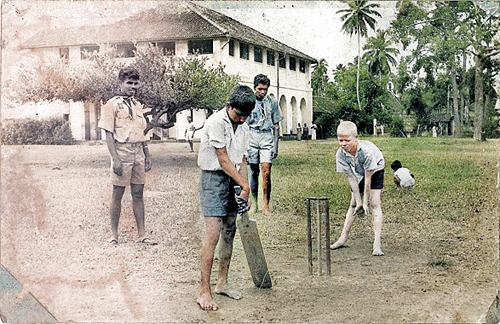A school like no other

Spacious setting: The School for the Deaf and Blind and students at activities (below)
Have you ever taken the time to think of how dependent you are on sensory information? Think of the time you woke up in the middle of the night and bumped into the table as you tried to make your way to the washroom. Or that time you played ‘pin the tail on the elephant’ or ‘Kana Mutti’ during Avurudu. Or when you couldn’t taste your lunch during a really bad flu season.
The ability to enjoy your favourite music, and to see the beauty of the universe is something we have become accustomed to since the day we first opened our eyes. But the thing is, some of us just don’t. We don’t open our eyes. We don’t ever hear the words ‘I love you.’ We don’t get to see the sun rise or set.
But this is not a story about the helpless and deprived. Not at all. This is an account of a great institution that took up the challenge to make bricks when there was absolutely no straw! The School for the Deaf and Blind in Ratmalana was inaugurated in 1912 by Mary F. Chapman of the Church of England Zenana Missionary Society (C.E.Z.M.S.) to address the needs of a neglected and marginalised population of both hearing and sight impaired children. The schools, that began in a rented house down Station Road in Dehiwala with just one day scholar and two boarders and four members of staff has grown to house over 225 students, 80% of whom are full-term boarders, and consists of an academic, administrative and support staff of over 100.
The school shifted quite a bit during its initial years. From its original location in Dehiwala in 1912, the school moved to what was supposed to be its permanent premises — a six-acre plot of land gifted by A.J.R. de Soysa at Kandawala, Ratmalana in July 1914. The Beven family of Veyangoda gifted a beautiful Chapel — The Chapel of the Holy Child at the school in 1922.
 In 1926 N.D.H. Abdul Caffoor generously donated the adjoining property of four acres to the Ratmalana school. Just as they were settling in, World War II, forced a move. Due to its proximity to the Ratmalana Airport and Railway compounds, the school was given less than 24 hours to vacate the premises (on 22/02/1942) and, as a result, in 1942, the abandoned railway stations at Yatiyantota, Karawanella and Dehiowita were occupied by the school.
In 1926 N.D.H. Abdul Caffoor generously donated the adjoining property of four acres to the Ratmalana school. Just as they were settling in, World War II, forced a move. Due to its proximity to the Ratmalana Airport and Railway compounds, the school was given less than 24 hours to vacate the premises (on 22/02/1942) and, as a result, in 1942, the abandoned railway stations at Yatiyantota, Karawanella and Dehiowita were occupied by the school.
The Ratmalana buildings were returned by the Royal Air Force in 1946 and the schools were separated both physically (beginning in 1949 and completed in 1951) and in its day-to-day administration, a decision taken in 1945 with the blessings of the Education Department. The Nuffield School for the Deaf and Blind, an offspring of the Ceylon School for the Deaf and Blind, was established in Kaithady in the Jaffna District in 1956 to serve the children of the North. Begun with eight differently abled students and four members of staff, today, it caters to 130 students with a staff of 57.
The three schools are presently governed by the Diocese of Colombo and managed by a Board of Trustees of the Ceylon Schools for the Deaf and the Blind, with the Bishop of Colombo as the Chairperson. As the pioneering institution in the country for blind and deaf education, the School and Board work towards transforming the lives of the visually and hearing impaired children, from being dependent individuals to responsible citizens. The aim has always been to ensure that both the blind and deaf, who pass through these institutions, be independent in their work and life, instead of becoming burdens to themselves and others. The school has always tried to provide a more customised and accommodative version of the same curriculum followed in traditional schools.
 The School for the Deaf has prepared students for both the Grade 5 Scholarship and O/L exam since 1997. To date, many students successfully pass the O/L exam and continue their A/L education at schools around the island. Miss L.M.V.K. Yakandawala (fondly known as Miss Violet) and R.M.H.P. Gunaratne are the first blind students to obtain B.A. degrees from a local university, whilst A.J. Bernard read for a degree at the University of London. The first blind lawyer, Wimal Wickramasinghe was also a product of the School for the Blind, Ratmalana. 2021 set another record when a student of the school, Brian Kingston, received 9A’s at the 2020 O/L exam.
The School for the Deaf has prepared students for both the Grade 5 Scholarship and O/L exam since 1997. To date, many students successfully pass the O/L exam and continue their A/L education at schools around the island. Miss L.M.V.K. Yakandawala (fondly known as Miss Violet) and R.M.H.P. Gunaratne are the first blind students to obtain B.A. degrees from a local university, whilst A.J. Bernard read for a degree at the University of London. The first blind lawyer, Wimal Wickramasinghe was also a product of the School for the Blind, Ratmalana. 2021 set another record when a student of the school, Brian Kingston, received 9A’s at the 2020 O/L exam.
Many academically driven students have and continue to join the staff at the school, including Miss Violet who taught History and Civics. It was in 1933 that the school employed a blind teacher for the very first time —D.V. Wimalasena. Today, the School for the Blind employs five blind staff members (all past pupils), including Vice-Principal — Mrs. Monica Peiris. The school aims at providing post Ordinary Level exam students with the necessary support in finding admission to the schools of their choice, and provide those institutions with the necessary services such as the translation of braille papers, provision of braille technology for students, etc.
2002 marked the first time students from the School for the Blind, Ratmalana used Braille Writers at the O/ L exams and many passed with flying colours, a feat that helped secure support for a large donation of 100 Braille Writers (the biggest donation of writers from a single donor) in 2007 by Chairman of Gateway Terminal Pvt. Ltd.
The School for the Blind is also a pioneer in promoting inclusive education. Placement of students in other traditional educational settings was supported by schools like Trinity College, S. Thomas’ College – Mount Lavinia, Prince of Wales College – Moratuwa and Arethusa College. Today, students from the School for the Blind, Ratmalana are members of various school communities including Ladies’ College, Sujatha Vidyalaya, Princess of Wales College, St. Peter’s College, Ibbagamuwa Central College, D.S. Senanayake College, Mahanama College, Holy Family Convent – Dehiwala, Holy Cross College – Kalutara, Sri Sumangala College – Panadura, Newstead College and Ananda College in addition to those previously mentioned.
Students are also provided with vocational training to help secure employment when the time arrives to leave the shelter of the School. The need for vocational training was felt as early as 1916, when Principal Gladys Bergg introduced weaving for the boys and needlework for the girls. Later, courses such as rattaning, basket making, massage therapy, carpentry, gardening, pottery, telephone operating, Vesak lantern production, and cane work were offered at the School for the Blind, and cooking, tailoring, dress making, hairdressing, I.T. skills, graphic designing, printing, book binding, coconut shell spoon making, poultry keeping, and gem cutting at the School for the Deaf.
Blind cricket was first introduced to the school in 1951 by K. Simons, a past pupil who had moved on to S. Thomas’ College, Mount Lavinia for his higher studies. The first exhibition match was played at S. Thomas’ Preparatory School, Kollupitiya, with Prime Minister D.S. Senanayake making the first delivery. Cricket is also available to the students from the School for the Deaf.
Music was and is a very important avenue in which the blind make great progress. A.B. Kulasekara and Mrs. R.A. Spencer-Sheppard founded a first rate choir with the adult blind men at the Kotte Industrial Home. Another individual who also assisted was none other than Bertie Samarakoon, brother of Ananda Samarakoon — composer of the National Anthem, by training them in Oriental Music.
The gift of a hall and stage in 1952 by J.L.D. Peiris has further enhanced the performing arts — music (orchestra, band and choir), dance (eastern and western), and drama. Many blind students spend a lot of their free time in such activities.
The school also has a long history with Scouting and Guiding and a very active Leo Club has been in operation since the 1980s.
The provision of boarding facilities for students from various backgrounds not only helps eases their families’ financial burdens, but ensures that they are kept healthy, safe, and immersed in the life of the school.
The concept of Free Education existed in the school since its inception in 1912. The school always operated and sustained itself through voluntary contributions. Entering the Government Scheme ensured the salaries for teachers. Everything the school has done was made possible by the kindness of donors who have funded and added new facilities (Multi-tone rooms, Audiology centres, weaving rooms, etc.), renovated and maintained current infrastructure, donated meals and equipment, and even volunteer their time and effort for the children.
As the Ceylon School for the Deaf and Blind aims at changing public attitudes towards its students, the success of its programmes depends on the continuous support extended by the entire community.
How can you help?
- By taking an interest in the school
- By seeking out deaf and blind students who may not be engaged or receiving the best possible education as offered here
- By offering to teach out-of-school activities to help the children occupy their leisure hours more productively
- By giving special material which the school needs but cannot afford: e.g Braille Writers, Arithmetic Boards, paint for buildings, etc.
- By giving regularly to the general fund and/or meal fund of the Ceylon School for the Deaf and Blind, and by promoting and enrolling in the Birthday Scheme — offering a gift of a meal for the students of the Deaf and Blind School as a thank-offering for the blessings received.
- By involving your organisation or school in contributing towards the deaf and blind children on a regular basis
- By participating at the Sunday chapel services at 4:30 p.m.
(The writer is Acting Principal of the School for the Deaf and Blind)
Searching for an ideal partner? Find your soul mate on Hitad.lk, Sri Lanka's favourite marriage proposals page. With Hitad.lk matrimonial advertisements you have access to thousands of ads from potential suitors who are looking for someone just like you.


